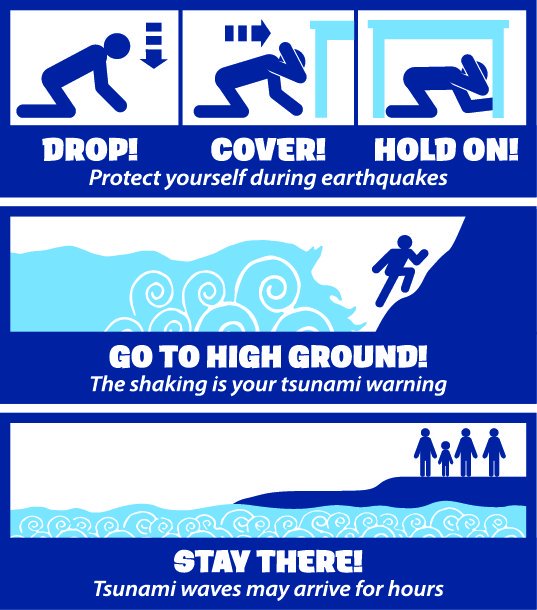 What to do in case of Tsunamis. Source tsunamizone.org
What to do in case of Tsunamis. Source tsunamizone.orgFor those who live, work or holiday in the coastal areas of Italy, the first things to know are that there is a tsunami risk, and that in a relatively small sea like the Mediterranean the arrival times of tsunami waves on the coast can be very short. The tsunami caused by an earthquake near the coast could hit some areas before the alert can be issued.
This is why it is very important to immediately recognise the signs which may precede the arrival of a tsunami:
- if you are on the beach or near the sea and feel that the earth is shaking;
- if you see a long and compact wave approaching on the horizon;
- if there is news of a strong earthquake near the coast;
- if you see the water level rising rapidly;
- if you see the water level falling rapidly;
- if you hear a deep and growing noise coming from the sea (like a train or a low-flying airplane)
In all these cases move immediately to higher ground and as far as possible from the coast, without waiting for the tsunami alert to be issued. In any case, remember that the beaches are NOT a safe place in the event of an earthquake near the coast. Find out about the contingency plans of the municipality of residence if you live in a coastal area.
In certain cases, tsunamis are preceded by the water near the shore withdrawing, which can uncover the seabed for tens or hundreds of metres. If you see this phenomenon, move away immediately upwards, without using the car, avoiding wasting time by taking pictures or videos with mobile phones: it can be very dangerous!
In any case, do not waste time, collect the bare essentials and run away immediately: lingering can cost you your life.
Remember that the force exerted by tsunami waves is enormous, much more than any seaquake or storm wave: a tsunami can move very large and heavy objects, even tens of tons, like blocks of rock, cars, boats, houses and debris of any kind for many hundreds of metres. The displacement of these materials can cause serious injuries or even death.
Video of the tsunami that struck Sulawesi (Indonesia) on 28 September 2018
If you are at home and receive a tsunami alert, let your family know and make sure everyone understands. If your house is located in a flood area, if it is on level ground near the coast, or if it is in the immediate vicinity of the sea, it is always better to move in an orderly, quiet and safe way to the evacuation areas or to any other safe place outside the evacuation area, following the instructions of the local emergency authorities and of the police.
If there are no hills, elevations or high grounds you could find shelter on the top floors of buildings. But remember that the safety of a building depends on many factors: the materials used in the construction, its height above sea level, its distance from the shore, the number of floors, its exposure to the impact of the wave. Generally, the upper floors of reinforced concrete buildings, such as multi-storey hotels located in many low-lying coastal areas, can offer adequate protection in the event of a tsunami if the building is well constructed.
If you are on a boat or ship outside a port and a tsunami alert is being issued for your area, head for the open sea as quickly as possible, where tsunami wave amplitudes are much lower and have a much smaller effect. Do not try to reach the harbour: tsunamis can cause rapid changes in water levels and dangerous and unpredictable currents in ports.
If when the tsunami warning is issued you are on board a boat or a ship in port, leave the boat moored and immediately walk away towards areas higher than sea level: there may not be enough time to move the boat to safe waters.
More information on the Civil Protection website.



